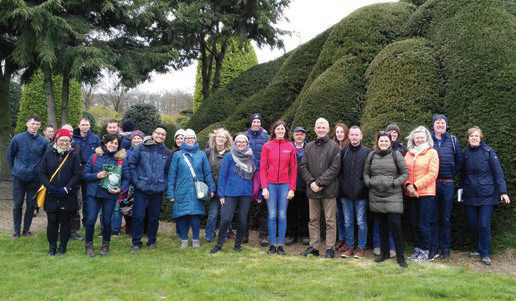John Mulhern, Principal of the National Botanic Gardens reports in from a recent student tour of the Netherlands and Belgium
In April of this year the staff and students from Teagasc, College of Amenity Horticulture in the National Botanic Gardens and Kildalton travelled to the Netherlands and Belgium to visit some of the best horticultural destinations Europe has to offer.
The tour began with a visit to Royal Flora Holland, the flower auctions in Aalsmeer. From the elevated walkway, which spans the length of the giant warehouse, we witnessed the hustle and bustle of what is the world’s largest flower auction in action. Thirty million plants are sold on a daily basis, exporting mainly to Germany, the United Kingdom and France. The logistics of how a warehouse the size of 220 football fields runs and operates is a thing to behold and left each one of us impressed with the magnitude of the operation.
From Aalsmeer, we travelled south to Belgium to visit a rare and special tree nursery. Solitair tree nursery specialises in the production of trees with diverse shapes and sizes. Here we received a passionate and very insightful tour by Valarie Cools, the daughter of Dirk Cools, who originally founded the company that he now operates with Valarie and his other daughter Emma. Solitair was a visit that really captured the student’s imagination, a very unique tree nursery who’s plant material ends up in large landscape projects all over Europe including Ireland.

On the second day of our trip, we began with a visit to Batowue nursery, a very different operation to that of Solitair. Batouwe was established by brothers, Willem and Henk Huibers in 2005 and specialise in the production of P9 grafts. We visited their Dodeswaard site consisting of five hectares of cutting comprising of mainly common and unusual tree and shrub varieties. Willem explained some of the new techniques they employ in the nursery, such as the Air Pot U system, that allows plants to generate a fibrous root system quickly and that secures better establishment upon planting in the fields. Batouwe produces over four million plants a year, of which two-million are P9’s. They export to over 25 countries worldwide. Our next visit was the royal gardens of Paleis Het Loo, a Dutch garden with impressive fountains and symmetrical parterres in the Apeldoorn region. A guided tour of the magnificent gardens and palace was given to us by one of the conservationists at the Paleis. Our tour guide, Emma explained how thousands of meters of boxwood hedging in the formal gardens had to be replaced in recent years after becoming infected with box blight.
On the final morning of our trip, we visited the Hortus Botanicus and Bloomenmarket in Amsterdam. Finally, no trip to Amsterdam would be complete without a visit to the world-famous tulip fields, to witness the blanket of colour that dominates the landscape for the month of April each year.
For more information on available courses please contact the College in the Botanics. ✽









